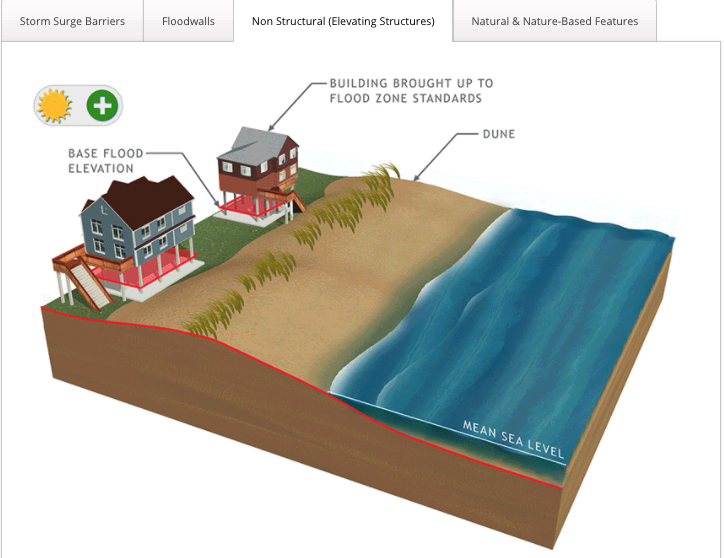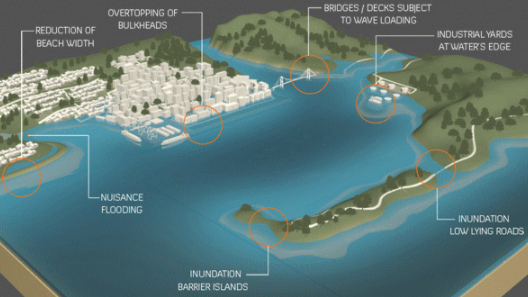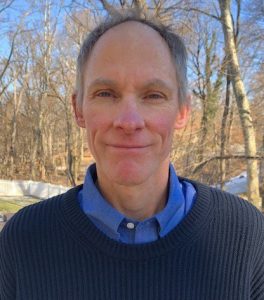
A graphic from the U.S. Army Corps of Engineers’ New Jersey Back Bay Study details one of several options for defending shorelines.
By Lauren Turner
On April 16, 2020, the Natural Hazards Speaker Series was joined by J.B. Smith of the U.S. Army Corps of Engineers (USACE). Smith is the Coastal Technical Expert for the Philadelphia District of the Corps. He spoke about the planning perspective of the Corps around coastal hazards and resilience. Earlier this semester, we heard from his Army Corps colleague, Julie Rosati, who presented the programmatic model of the Corps. Smith’s presentation was a follow-up on that, delving into specific programs (namely the New Jersey Back Bay) as well as barriers to implementing preferred techniques.
Smith works in the Coastal Storm Risk Management program, which focuses on beach erosion and restoration, shoreline protection, urban inundation and sea level rise. Smith said USACE addresses these issues through engineering and practice-based solutions. Many projects take up to 10 years, and the Corps is constantly conducting research to propose new and better solutions. As Smith puts it, “The Corps is the nation’s engineers”.
The planning process that the Army Corps uses is as follows: (1) Identify problems and opportunities, (2) inventory current conditions and forecast future ones, (3) formulate alternative plans, (4) evaluate alternative plans, (5) compare alternative plans and (6) select a plan. Smith said that at each stage of this planning process, there is more opportunity for community engagement, and more stakeholders become involved at each level.
Smith presented the Corps’s North Atlantic Coast Comprehensive Study to the class. This report had two stated goals: To provide a risk management framework, and to support resilient coastal communities. USACE is not trying to prevent communities from being near the water, nor move them, he said. Rather, they proposed a combination of structural, practice-based and programmatic solutions so that current communities’ future risk is reduced in the face of sea level rise. Solutions included storm surge barriers, levees, nature-based features, floodproofing, buyouts, land use planning, water resource management and more. The Corps proposed that a combination of numerous techniques would be most effective in forming a plan to optimize resilience. Most importantly, the report necessitates a “paradigm shift,” or total lifestyle assessment and adjustment, for coastal communities to be sustainable.
The New Jersey Back Bays Study was the main case study presented by Smith. The Army Corps has constructed floodwalls along the coast of New Jersey, and is proposing more. They propose enhancing floodwalls and levees, expanding marshes and improving municipal drainage infrastructure. Their most ambitious proposal, however, is for massive floodgates across the Great Egg Harbor Inlet. These gates would be modeled after those used successfully in Scandinavia.
Smith also discussed how different types of solutions are viewed by the public. While USACE engineers are passionate about the inlet flood gates, for example – and for good reason, as they are an accepted and popular engineering solution in other parts of the world – the gates are a “hard sell” because of environmental issues. Environmental groups worry about the damage that the gates could do to natural habitats and the effect they may have on sediment or the harbor floor. The gates are also the most difficult solution: the engineering and building of them would take years, and would be very expensive. This presents a conundrum, in that the solution most recommended by the engineers is also the one that is the most difficult to bring to fruition.
According to Smith, nature-based features are the most popular solutions. Using natural features to mitigate effects of storm surge and sea level rise is a relatively cheap solution; it appeals to environmentalists; it carries the societal plus of not being an eyesore; and, as we learned last semester, some nature-based solutions like sand dune renourishment can be done by volunteers. The solution that Smith sees as simplest, however, is not using nature-based features but actually elevating construction – that is, raising houses and buildings onto stilts or raised foundations. This may prevent damages done by flooding, but would be less effective mitigating other storm effects.

A U.S. Army Corps of Engineers graphics shows potential impacts of sea level rise on coastal communities.
The least popular solution, according to what Smith has seen, is high sea walls. We have seen this in Japan – coastal cities affected by tsunamis have built walls taller than people all along the shore, completely blocking out the view of the ocean that so many shoreline-dwelling communities treasure.
Smith pointed out that when judging project types, the difficulty, popularity, and expense of each are like a Venn diagram in which nothing completely overlaps, making it difficult to find the perfect solution to implement. The massive infrastructure changes, financial investments and people power necessary to research, design and propose these solutions is only the tip of the iceberg. Getting plans approved, funded, and implemented is another challenge in itself. Yet the Army Corps of Engineers moves forward, working every day to develop innovative plans to protect coastal communities in the coming decades.
Lauren Turner is a first-year master’s student in the Department of City and Regional Planning, specializing in Housing and Community Development. She is also pursuing a graduate certificate in Natural Hazards Resilience. Prior to UNC, she worked in refugee services and labor union administration. Turner holds a bachelor’s degree in International Relations from UC Davis.

